
|
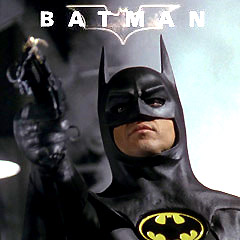
|
Super-Heroes Batman |
(chronological by time period and film title) Introduction | Flash Gordon | Buck Rogers | Superman | Batman | Spider-Man | X-Men Marvel Cinematic Universe | The DC Extended Universe Iron Man | Hulk | Thor | Captain America | The Avengers | Guardians of the Galaxy Others: A - F | Others: G - N | Others: O - Z |
(chronological by time period and film title) |
|||||||||||||||||||||
Batman (the Dark Knight or the Caped Crusader) - was based on the DC Comics' Batman character created by cartoonist/artist Bob Kane and writer Bill Finger. Batman first appeared in Detective Comics # 27 (May 1939). Commissioner James Gordon also made his first appearance in Detective Comics # 27, at the same time that Batman himself first appeared. Batman's origin story was in Detective Comics # 33 (November 1939) - detailing his background as playboy millionaire Bruce Wayne. Unlike Superman, Batman had no superpowers, but he had many ingenious weapons, including a grapple gun and utility belt, and he was a master of martial arts. He donned a mask in the shape of a bat, and fought crime at night on the streets of Gotham City. He was a dark character, who was dedicated to vengefully fighting crime and finding justice after witnessing the murder of his parents. [Note: In Bob Kane's early drafts of the character, Batman wore a bright red tunic, a black eye mask and wings.
Robin ("The Boy Wonder") - shortly after the inauguration of Batman, sidekick Robin was introduced in Detective Comics # 38 (April 1940). He was originally an orphaned acrobat named Dick Grayson, who served as Batman's helpful protege. Together, they were dubbed "The Caped Crusaders," and "The Dynamic Duo." Robin appeared as the solo subject of his own comic book series, beginning with Star Spangled Comics # 65 (February 1947), heralding: "Now! A Thrilling New Series of Smash Adventures Starring Batman's Famed Partner-In-Peril Robin The Boy Wonder in Solo Action!" Over the years, there were many transmogrifications of Robin's character, including:
Batman soon was featured on the cover of his own comic book, beginning with Batman # 1 (issued April 25, 1940). This issue also introduced two of Batman's main villains, The Joker and Catwoman.
Before Batman became a well-known movie and TV icon, he had also appeared in newspaper comic strips. The first series of Batman comic strips (both daily and Sunday) made their appearance from 1943 to 1946. The strip was written by Bob Kane and others, and was first titled Batman and Robin. Both the daily and Sunday comic strips, released during the war years when paper resources were scarce, have since been gathered together, compiled, reprinted, and made available in book form.
The campy late 1960s Batman TV series was popular for only a few years, causing a desire to return to Batman's darker roots in the early 1970s. He became more of a loner who never showed his face, and often worked alone (without sidekick Robin). He moved from the Wayne Manor mansion into a penthouse apartment in downtown Gotham City, closer to the activities of criminals. Batman became a fearsome creature of the night, battling underworld forces. This dark change in Batman's character was reflected in writer Frank Miller's and DC Comics' comic book mini-series, Batman: The Dark Knight Returns (1986), reportedly inspired by the popularity of Clint Eastwood's vigilante "Dirty Harry" character in a seres of films. The 4-issue monthly series, drawn by Frank Miller and Klaus Janson, ran from March to June 1986. The name "The Dark Knight Returns" was actually only the name of the first issue of the mini-series, but has become the name most associated with the series as a whole.
The Batman story was set 20 years into a dystopian near-future, with 55 year-old Bruce Wayne as the costumed superhero, who had retired after 10 years of fighting crime in Gotham City. But he returned to his destiny of fighting crime, acquiring a new Robin (13 year-old female Carrie Kelley). He battled against villains and arch-enemies, including Harvey Dent/"Two Face," the Mutants Gang, and the Joker. And in a controversial move, Batman fought against his old ally, Superman, the Man of Steel, now serving as an agent of the US government. This comics series (with the Watchmen) marked the beginning of the Dark Age of Comic Books (also known as the Modern Age). Frank Miller's comic book series was the inspiration for a two-part, direct-to-video animated superhero film, titled Batman: The Dark Knight Returns (2012-2013). It also heavily influenced the first major Batman film, Tim Burton's Batman (1989). The comic book character
of Batman starred in eight full-length, live-action movies
from 1966 to 2012. It was a record for the most movie adaptations
of a comics character. |
|||||||||||||||||||||
Batgirl / Oracle - originated in DC Comics' Detective Comics # 359 (January 1967), with the blazing headline: "The Million Dollar Debut of Batgirl!" Batgirl was actually Barbara Gordon, the daughter of Gotham City's Police Commissioner James Gordon, and an ally of Batman (and Robin) as Batgirl (with an appropriate looking Batsuit), and skilled in the martial arts (Kali fighting sticks). Her occupation by day was as a smart librarian. The Batgirl character (performed by Yvonne Craig) appeared in the live-action, 3-season Batman TV series in the late 1960s, in the third season (see below), and the trio of Batman, Robin, and Batgirl were known as the "Terrific Trio." In the story line in the year 1988, in Alan Moore’s graphic novel The Killing Joke, Barbara (who had just retired at age 19!) was shot in the spinal cord by the Joker, and was left paralyzed and in a wheelchair. Thereafter, Barbara was transformed into a computer-hacking mastermind known as Oracle, appearing first in an issue of Suicide Squad # 23 (January 1989) - a female crimefighter with a photographic memory. Her identity was fully revealed as Barbara Gordon in Suicide Squad # 38 (February 1990).
|
|||||||||||||||||||||
| Super-Hero Films | |||||||||||||||||||||
 |
Batman (1943) - Theatrical Serial Batman was the first DC Comics character to have his own serial. The earliest Batman on film was in this low-budget, 15-episode serial (270 minutes in length) from Columbia Pictures, directed by Lambert Hillyer and titled Batman (1943).
The opening credits stated: "Based on the Batman comic magazine feature appearing in detective comics and Batman magazines, Created by...Bob Kane." Each episode ended with a cliff-hanger, which was repeated at the beginning of the next week's episode. The introductory episode was about 26-27 minutes long, while the others were shorter. Lewis Wilson starred as smug playboy Bruce Wayne with alias superhero Batman, "America's No. 1 crime fighter," and Douglas Croft as his "young two-fisted assistant" Robin/Richard "Dick" Grayson - they were a crime-fighting duo. Shirley Patterson played the part of secretary Linda Page, Bruce's girlfriend who often necessitated rescue. There was no Batmobile in both 1940s serials, although this series introduced butler Alfred Pennyworth (William Austin), and the BatCave. The villain, portrayed with racist overtones (during WWII) was diabolical, shifty-eyed Japanese criminal mastermind Dr. Tito Daka (aka Prince Daka) (J. Carrol Naish), agent of Emperor Hirohito. He possessed a "new secret weapon" - a destructive radium-powered death ray that could crumble a concrete wall into rubble. He was planning to steal the city's radium supply. He was also noted as a mad scientist who could turn his enemies into electronically-controlled zombies (controlled by his magic ring), and he possessed an alligator pit beneath a trap-door in his living room. His hideout called "The House of the Open Door" was located behind the Cave of Horrors carnival ride in Little Tokyo. The first episode of the serials, "The Electrical Brain," began with a long voice-over narration:
When the serial was revived in the mid-1960s, it was re-released and retitled: An Evening With Batman and Robin (1965) - with all of the serial's episodes played straight-through from beginning to end (see below). |
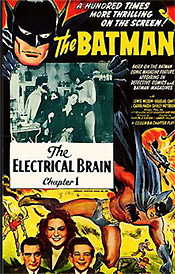
|
|||||||||||||||||||
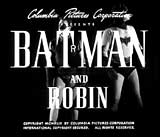
|
Batman and Robin (1949) A second version of the Batman/Robin superhero saga, this sequel was a 15-part weekly serial from Columbia Pictures and directed by Spencer Bennett. It was titled Batman and Robin (1949), and described in the opening credits as: "Based on the Batman Comic Feature appearing in Detective Comics and Batman Magazines, Created by Bob Kane." The first episode was about 26-27 minutes long, while the rest were about 17 minutes each. Every chapter (except the last) ended with a cliff-hanger, which was repeated at the beginning of the next week's episode. It had different actors than the 1943 Batman serial. This one starred Robert Lowery as Batman/Bruce Wayne ("a wealthy playboy"), who lived in the Wayne residence (with the Batcave below) located in the suburbs of Gotham City, and John Duncan as his sidekick Robin/Dick Grayson ("the boy wonder"). The dynamic duo were "famed crusaders for law and order." The villain in this second series (revealed at the end) was the hooded Wizard (Leonard Penn), also playing the part of Carter, Professor Hammil's (William Fawcett) valet. The serialized film opened with voice-over narration: "Crime, stalking our city by night and day, is on the increase. Our undermanned police force is helpless to cope with the situation, but they have an ally - Batman - who with the faithful Robin, wages unending war against all criminals!"
|
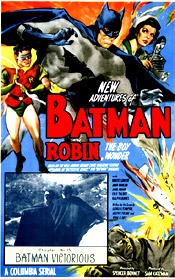
|
|||||||||||||||||||
An Evening With Batman and Robin (1965) - Full-Length Serial All episodes of the original 1943 serial were played straight-through from beginning to end, in this re-issued title, with no added footage. This theatrical release from Columbia Pictures, about 4 and a half hours long, was first released in late 1965. It was advertised as "Four Frantic Hours of Fun!! Of the GREAT SERIAL CLASSIC that is electrifying The World." Sometimes the film was shown in two parts (the first 8 chapters of the original serial in part 1, the next 7 chapters in part 2). A marathon showing (dubbed "CINETHON") was considered a 'participatory' show: "Come and HISS the Villainous Wily Orientals! - Come and CHEER the Intrepid Incredible Batman." |
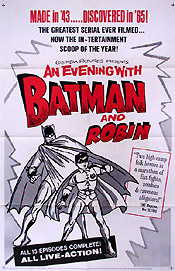
|
||||||||||||||||||||
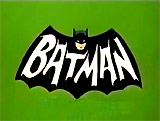
|
Batman (1966-1968) - TV Series One of the oldest superheroes was given a new lease on life - on television, and it even helped to boost circulation of the comic books. Batman was a live-action, 30 minute episodic, prime-time TV series broadcast on the ABC-TV network, first with two-part stories airing on Wednesday and Thursday nights. The Wednesday night story usually ended with a cliffhanger. Batmania soon swept the nation, although it would only last a little over two years. In the campy 1960s show, Adam West starred as the Bruce Wayne/Batman character, while Burt Ward portrayed his sidekick Dick Grayson/Robin. There were numerous villains that battled the "Dynamic Duo" over the 3 seasons: The Joker (Cesar Romero), The Penguin (Burgess Meredith), Catwoman (Julie Newmar, and Lee Ann Meriwether, and Eartha Kitt in the 3rd season), and The Riddler (Frank Gorshin, in the 1st and 3rd seasons, and John Astin). Other comic-book villains (with famous cameos) who appeared from time to time included The Mad Hatter (David Wayne), Egghead (Vincent Price), King Tut (Victor Buono), False Face (Malachi Throne), Mr. Freeze (George Sanders, Otto Preminger, and Eli Wallach), The Puzzler (Maurice Evans), The Clock King (Walter Slezak), and The Archer (Art Carney). There were a number of gadgets/vehicles employed by Batman: a Batmobile, a Batcycle, a Batboat, and a Batcopter. During its fight sequences, it was known for using onomatopoeia for the sounds of battle, and cartoonish balloons: "CRASH!", "OWWW!", "PLOP!", "WHAP!", "BAM!", "WHAM!" and "POW!", for example. In the third season, a new character was introduced to bolster ratings, Yvonne Craig joined as Batgirl / aka Barbara Gordon. She was Gotham City Police Commissioner James Gordon's daughter who worked at the Gotham Library. ABC-TV aired Batman for three seasons, a total of 120 episodes:
|
||||||||||||||||||||

|
Batman (1966) (aka Batman: The Movie) This was the first full-length Batman theatrical feature film, a campy, zany, silly, and comical film titled Batman (1966) from 20th Century Fox, and directed by Leslie H. Martinson. It was noted as being a parody, with cheap special effects and tongue-in-cheek dialogue. With trademark exclamations displayed on the screen, such as "Splat!", "POW!", and "Ouch!" It was based or spun-off from the popular 1966-1968 Batman TV series (see above), and starred most of the members of the original TV cast, including Adam West as Gotham City's caped crusader Bruce Wayne and Burt Ward as the Boy Wonder Robin (aka Dick Grayson). There was a host of villains in Gotham City together fighting against Batman as the United Underworld:
West and Ward would go on to portray Batman and Robin in voice only for several Saturday morning-cartoon versions of Batman. |
 
|
|||||||||||||||||||
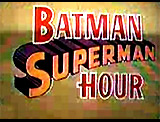 The Batman-Superman Hour (1968-1969) 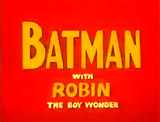 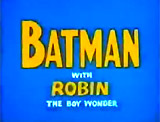 Batman with Robin the Boy Wonder (1969) (aka The Adventures of Batman) |
The Adventures of Batman (aka Batman with Robin the Boy Wonder) (1968-1969) - TV series While the live-action prime-time TV series Batman had just finished airing on ABC-TV in March of 1968, there was another animated TV series in the works, produced by Filmation Studios. It was the animated TV series The Adventures of Batman (1968-1969), broadcast on CBS-TV during one season from 1968-1969. Olan Soule was the voice of Batman, while famous top-40 DJ Casey Kasem was the voice of Robin, the Boy Wonder. These 34 cartoons first aired in 1968 as part of the 60-minute program (Saturday morning airings) titled The Batman/Superman Hour (1968-1969). [At first, Batman had shared TV time with Superman shorts.] The 34 cartoons were re-run from 1968-1969 in 17 episodes of The Adventures of Batman, in chronological order below, airing from September 14, 1968 to January 4, 1969. There were 34 story-episodes or cartoons (each 12 minutes in length). This marked the animation debut of super-hero and caped crusader Batman. The first story was presented in two 6 1/2 minute segments, and the second story in a single 6 1/2 minute segment:
In 1969 in its second year, Superman was dropped completely from The Batman-Superman Hour. A re-titled or repackaged 30-minute version premiered on CBS-TV on September 13, 1969. It was renamed Batman with Robin the Boy Wonder (1969) (aka The Adventures of Batman), and was composed of reruns from the first season in 1968. |
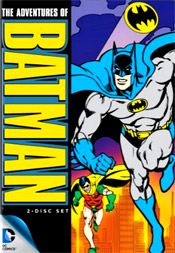
|
|||||||||||||||||||
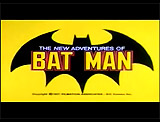
|
The New Adventures of Batman (1977) - TV series This was the second Batman animated series produced by Filmation, after their 1968-1969 animated Batman series. This animated series of 30-minute Saturday morning shows debuted on CBS-TV, running from February 12, 1977 to May 28, 1977. This was one of the last Batman cartoons to air on television, until 1992's Batman: The Animated Series (1992-1995). This was the first time that both Adam West and Burt Ward returned to their famous roles as Batman and Robin since the end of the live-action show in 1968. The lead actors of the popular 1966-1968 Batman TV series were the two lead voices. The character designs for most of the characters (except Commissioner Gordon) were retained from the earlier series, although the more sophisticated animation technique of rotoscoping (tracing the characters' movements over live action footage) was used to give the characters a more fluid movement. Each episode also contained a short, moralistic "Bat Message" at the end. There were 16 episodes in Season 1:
|
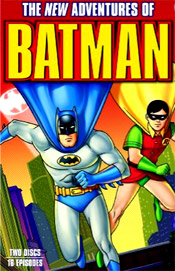
|
|||||||||||||||||||

|
The All New Super Friends Hour (1977- ) - TV series This animated series was produced by Filmation's competitor, Hanna-Barbera Productions. Batman and Robin were also featured in their own cartoon series, The New Adventures of Batman (1977), produced by Filmation and airing on CBS (see above). This marked perhaps the only time in which the same character was featured simultaneously on two different TV series, produced by separate companies and airing on rival networks. The characters of Batman and Robin were voiced by Olan Soule and Casey Kasem, who had also voiced the pair for Filmation's The Batman/Superman Hour (1968-1969). In 1977 during Season 2 (now retitled The All New Super Friends Hour, after it was called Super Friends in 1973), there were 15 hour-long shows, running from September 10, 1977 to December 10, 1977, broadcast on ABC-TV. There were four animated segments or story shorts per hour-long show or program. Usually, Batman and Robin were teamed up in either the first segment (A) or fourth segment (D).
The Super Friends series changed its name from year to year, and its many incarnations were on the air until 1985:
|
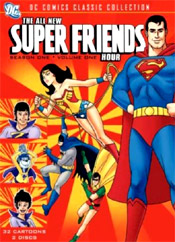
|
|||||||||||||||||||
There were seven major, live-action Batman feature-length
films (all from Warner Bros.)
|
|||||||||||||||||||||
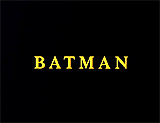
|
Batman (1989) The first film in a long-running franchise Batman series from Warner Bros. was a reprise of the character from the popular, campy mid-60s TV series and its accompanying full-length feature film in 1966 about superhero Batman. The title character was also known as the Dark Knight or the Caped Crusader, based on DC Comics' Batman created by Bob Kane. Director Tim Burton's Batman (1989) was a noirish, dark blockbuster epic film featuring Michael Keaton as Batman, Jack Nicholson as the Joker and Kim Basinger as Vicki Vale. Comic book fans sent thousands (50,000) of letters to Warner Bros. to protest Michael Keaton's casting as Batman. Jack Nicholson, portraying the Batman's arch-enemy the Joker in Tim Burton's comic-book blockbuster, took a stake in the film's profits (and merchandising). He reportedly netted $50 million as his personal take. |
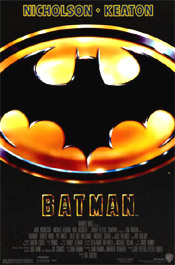
|
|||||||||||||||||||
|
Batman: The Animated Series (1992-1995) - TV series This was an animated TV series adaptation of the comic book series featuring the DC Comics superhero, Batman (with the voice of Kevin Conroy). It was a striking, stylized series that helped to revitalize the familiar comic book hero. With high quality writing and artwork, although with a somber portrayal of the superhero, it appealed equally to adult audiences and to children, captivated by the new standard of animation with its revolutionary visuals and phenomenal storytelling. The prime-time TV series, produced by Tim Burton, was the first of the modern DC Animated Universe (DCAU). It was entirely separate from the previous continuity of animated Warner Bros. DC Comics adaptations such as Super Friends. The series was possible after the success of Tim Burton's Batman (1989). The series aired on the Fox-TV network from 1992 to 1995, for four seasons. After the first seventy episodes aired successfully in the first two seasons, Warner agreed to finance the production of another fifteen. This was done partially to help promote the Robin character, who would be featured in the upcoming Batman Forever (1995) film. There were a total of 85 episodes (each of 22 minutes duration). There were two series. The first series aired on weekday afternoons, premiering in September of 1992.
The second series, premiering in September of 1993, aired on weekends (Saturday mornings) and was renamed The Adventures of Batman & Robin (1994-1995).
|
 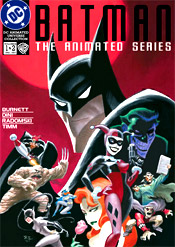
|
|||||||||||||||||||
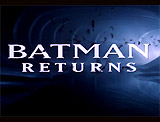
|
Batman Returns (1992) Director Tim Burton's own sequel, the visually-stunning Batman Returns (1992) again starred Michael Keaton. Typical of Tim Burton films, it contained oddball, unusual characterizations. Danny DeVito was the Penguin and Michelle Pfeiffer was the Catwoman. A more action-packed (but suspenseless), cartoony, gothic (or noirish), kinky, mean-spirited, and visually-stunning film than its predecessor. Although the PG-13 film received critical acclaim, some of its action-oriented, relentless violence and sexual innuendo-filled dialogue also received backlash and criticism by parental groups. This was the last Batman film to pair director Tim Burton with lead actor Michael Keaton. |

|
|||||||||||||||||||

|
Batman: Mask of the Phantasm (1993) (The Animated Movie) This adult-oriented, animated full-length feature Batman: Mask of the Phantasm (1993), was based upon the popular 1990s animated TV series (see above), with voices provided by Kevin Conroy (Batman/Bruce Wayne), Dana Delany (Andrea Beaumont), and the Joker (Mark Hamill). It was taglined: "The Dark Knight fights to save Gotham City from its deadliest enemy." The film was rated PG in theaters (although quite violent) and was a box-office failure despite earning positive critical reviews. However, it earned an audience through the home video market and its original direct-to-video release, and has become one of the most highly regarded animated films of recent years. This was the first film (of four) to be a spin-off of Batman: The Animated Series (1992-1994) (inspired by the Tim Burton films) (see above). The other three direct-to-video animated features were (see further below):
|
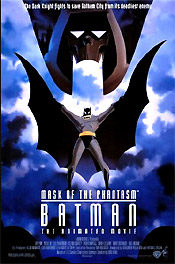
|
|||||||||||||||||||
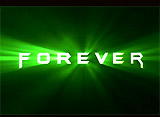
|
Batman Forever (1995) Director Joel Schumacher's lighter Batman Forever (1995) starred Val Kilmer as the hero and Chris O'Donnell as his sidekick, and a number of memorable villains, including Jim Carrey as the Riddler/Edward Nygma, Tommy Lee Jones as Harvey "Two-Face" Dent, and Nicole Kidman as the love interest Dr. Chase Meridian. A campier, more mainstream film. The third film in the Warner Bros.' series of Batman films. The film was received with mixed reviews. |
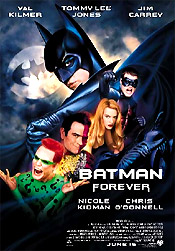
|
|||||||||||||||||||
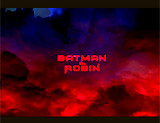
|
Batman & Robin (1997) Director Joel Schumacher's stylized sequel Batman & Robin (1997) starred George Clooney as the hero and Alicia Silverstone as Batgirl, Arnold Schwarzenegger as Mr. Freeze and Uma Thurman as Poison Ivy. The tongue-in-cheek tone nearly spelled the disaster of this type of super-hero film. The film was fast-paced but directionless, lightweight and mind-numbing. George Clooney never heard the end of it for his dual role as Bruce Wayne and as the rubber-nippled caped crusader Batman with a codpiece. The least successful of all the films in the series, and considered the worst entry. This campy and foolish retread had marvelous sets, gaudy costumes, and expensive production-design values, but turned out to be laughable in the worst way, with senseless action sequences, visual overload and too many corny jokes ("All right everyone, CHILL!", "Let's kick some ice," "Ice to see you," and "So many people to kill, so little time"). |

|
|||||||||||||||||||
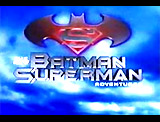 The New Batman-Superman Adventures |
The New Batman Adventures (1997-1999)
- TV series The New Batman Adventures TV series was a continuation of Batman: The Animated Series (1992-1995), that aired on Fox-TV until 1995. This new series aired on the WB-TV network from September 13, 1997 to January 16, 1999, for two seasons. There were a total of 24 episodes. The New Batman Adventures (1997-1999) show (produced by WB) was combined or merged with Superman: The Animated Series (1996-2000), to produce a new hour-long show, called The New Batman-Superman Adventures (1997-2000).
Each half-hour episode in the time slot featured either a single repeat from the original Superman: The Animated Series run, a repeat from the original Batman: The Animated Series run, or a brand new story featuring Batman made specifically for this series, drawn in an animation style to match Superman: The Animated Series. |
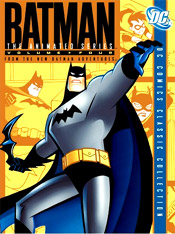
|
|||||||||||||||||||

|
Batman Beyond (1999-2001) - TV series WB (in collaboration with DC Comics) premiered this animated TV series on January 10, 1999. It was a continuation of earlier TV series, both Batman: The Animated Series (1992-1995) and The New Batman Adventures (1997-1999). It was specifically created to appeal to a younger age demographic. The series ran for three seasons, with a total of 52 episodes. It ran on both Saturday mornings and on weekdays. In the plotline, mentoring Bruce Wayne gave his cape and transferred his identity to teenager Terry McGinnis.
|
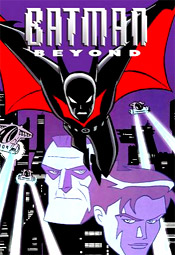
|
|||||||||||||||||||
 
|
Batman & Mr. Freeze: SubZero (1998) The first animated feature derived from Batman: The Animated Series of the 1990s. It was direct-to-video and 70 minutes in length. |
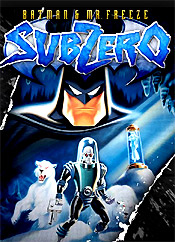
|
|||||||||||||||||||
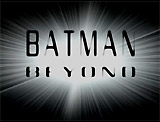  |
Batman Beyond: Return of the Joker (2000) The second animated feature derived from Batman: The Animated Series of the 1990s. It was direct-to-video, 74 minutes in length. |
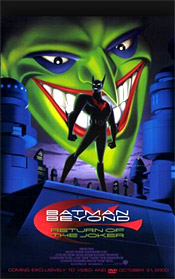
|
|||||||||||||||||||
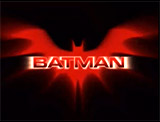 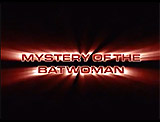 |
Batman: Mystery of the Bat Woman (2003) The third and final animated feature derived from Batman: The Animated Series of the 1990s. It was direct-to-video, 75 minutes in length. |

|
|||||||||||||||||||

|
Catwoman (2004) The live-action film Catwoman (2004) starred Halle Berry as the whip-cracking, evil-fighting feline character adept in the Brazilian martial art of capoeira. Critically-assailed with contempt, and bearing little relation to the previous DC Comic character portrayed by Michelle Pfeiffer in Batman Returns (1992). From its seven Razzie nominations, it won four: Worst Actress (Berry), Worst Director, Worst Picture, and Worst Screenplay. |

|
|||||||||||||||||||
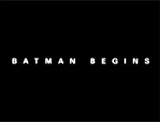
|
Batman Begins (2005) Director Christopher Nolan's dark Batman Begins (2005), concentrated on the origins of the Batman saga/legend, with the hero Bruce Wayne/Batman (Christian Bale). Director Christopher Nolan waited eight years before this reintroduction (reboot) of the character. The franchise series was started afresh in order to create a break from the previous Burton/Schumacher films. Close Wayne allies included Wayne's training mentor Henri Ducard (Liam Neeson), trusted family butler Alfred (Michael Caine), cohort and Wayne Enterprises' chief inventor and head of R&D Lucius Fox (Morgan Freeman), and childhood friend and young assistant DA (Katie Holmes). Other characters included Gotham City detective Lt. James Gordon (Gary Oldman), the leader of the quasi-terrorist League of Shadows group Ra’s Al Ghul (Ken Watanabe) and secondary villain Dr. Jonathan Crane/Scarecrow (Cillian Murphy). |
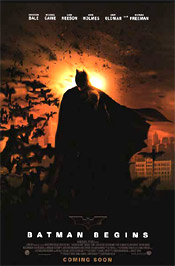
|
|||||||||||||||||||
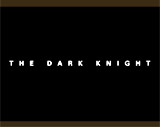
|
The Dark Knight (2008) Christopher Nolan's sequel The Dark Knight (2008) starred Christian Bale reprising his role as Bruce Wayne/Batman (in a sleeker bat-suit), and deceased co-star Heath Ledger (who tragically died shortly after the film's shoot) as the villainous, ghoulish bank robber named the Joker. A violence and action-packed superhero film based on the decades-old comic-book hero, with the tagline: "Welcome to a World Without Rules." Lucius Fox (Morgan Freeman) served as the twinkle-eyed, trustworthy Wayne Enterprises inventor and head of the Applied Sciences Dept. He provided Bruce Wayne (Christian Bale) with the gadgets and equipment (i.e., the Batsuit, the Tumbler, the Batpod) required for his exploits, Batman’s version of James Bond's Q. Also, he counseled him as a calm parental surrogate, took over CEO responsibilities, and served as the film's moral or ethical center when he expressed concern over Batman's invasive use of surveillance technology. The Dark Knight (2008) became the highest-grossing (domestic) Batman movie ever, the second highest-grossing (domestic) superhero film of all time, and the second highest-grossing (worldwide) Batman film of all time. Director Christopher Nolan brought his 'Batman trilogy' to a close with the next Batman film: The Dark Knight Rises (2012), following after his own Batman Begins (2005) and The Dark Knight (2008). It was notoriously snubbed for a Best Picture Academy Award nomination, and some credit its omission with forcing the Academy to expand the number of nominees to 10 in 2009. |

|
|||||||||||||||||||
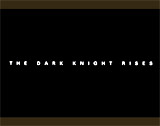
|
The Dark Knight Rises (2012) Director Christopher Nolan's third and final Batman film, The Dark Knight Rises (2012) reprised Christian Bale as Bruce Wayne/Batman, and also starred Anne Hathaway as Selina Kyle, and Tom Hardy as villainous Bane. With the tagline: "A Fire Will Rise." The Dark Knight Rises (2012) became the second highest-grossing (domestic) Batman movie ever, the third highest-grossing (domestic) superhero film of all time, and the highest-grossing (worldwide) Batman film of all time - it was one of only a small group of films to reach $1 billion worldwide. With a production budget of $250 million (estimated) - it was the most expensive of the Batman films (to date). To date, it had the longest run time of the Batman films, at 2 hours 45 minutes. The PG-13 rated screenplay was written by Nolan with his brother Jonathan from a story conceived by the director and David S. Goyer. Themes and characters were interwoven into the narrative from both previous Batman films. As a result of the movie theatre shooting massacre in Aurora, Colorado during the midnight screening of the film, Hollywood movie studios decided that they would not report the film's weekend ticket sales out of respect for the victims - it was a modern-day first for the film industry. Some considered the Christopher Nolan superhero trilogy tragically cursed, after actor Heath Ledger (portraying the Joker in the second film The Dark Knight (2008)) died of an accidental drug overdose just before the film premiered. The film had many ties to Dickens and specifically to his A Tale of Two Cities and Oliver Twist novels -- references to the French Revolution (and the mob pillaging homes of the rich), pickpocket opportunist Selina Kyle similar to the cunning Artful Dodger, a portrait of Napoleon in Catwoman's house, the character named Stryver, Gordon's eulogy reading from the leather-bound Tale of Two Cities book at Bruce Wayne's burial, and the existence of orphans (Wayne, Blake). |

|
|||||||||||||||||||
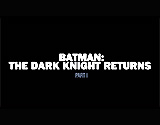 Batman: The Dark Knight Returns, Part 1 (2012) 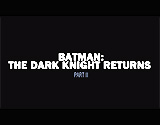 Batman: The Dark Knight Returns, Part 2 (2013) |
Batman: The Dark Knight Returns (2012-2013) - Animated Frank Miller's comic book series The Dark Knight Returns (1986) (see above) was the inspiration for this two-part, direct-to-video animated superhero film. Each part was 76 minutes in length.
A two-part deluxe compilation was also released on October 8, 2013. Peter Weller starred as the voice of Batman/Bruce Wayne, Ariel Winter as Carrie Kelley/Robin, and Michael Emerson as The Joker. |
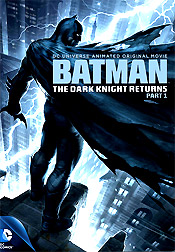 
|
|||||||||||||||||||
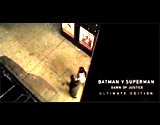
|
Batman v Superman: Dawn of Justice (2016) This special-effects laden superhero action film, Batman v Superman: Dawn of Justice (2016), directed by Zack Snyder, starred Ben Affleck as Batman, Henry Cavill as Superman, and Gal Gadot as Wonder Woman (in her first live-action screen appearance). Also Jesse Eisenberg portrayed Superman's long-time nemesis - the bald, smart villain Lex Luthor. Chronologically, this was the second film in the DC Extended Universe. |
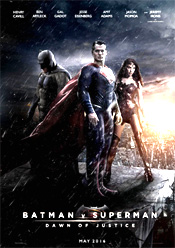
|
|||||||||||||||||||